
a P889C51RB2 part were used. In this case the code would enable the shadow boot block by setting the ENBOOT bit to
‘1’ and then jumping into ROM at location FC00h. If the watchdog timer is used it should be disabled before jumping to
the ISP code.
3-Track MSR
2-wire serial communication
By default, data from a successful card read is presented to the host with only the start sentinel [SS], followed
by the card data, followed by the end sentinel [ES]. The [SS] for track 1 is ASCII "%". The [SS] for track 2 is
ASCII ";". The [SS] for track 3 is ASCII "+". The [ES] for all tracks is ASCII "?". In the case of an
unsuccessful read, an ASCII "E" is returned without a [SS] or [ES] for that track or tracks. For example "EEE"
would be returned for all tracks if all three tracks had bad data. For example if only track 2 had an error, then
the reader would send [SS]track 1 data[ES]E[SS]track 3 data[ES].
Host commands to the MSR are sent through the 2-wire serial interface at 19200 Baud in the 8 bit, 1 stop no
parity format.
PS/2 Keyboard communication
By default, data from a successful card read is presented to the host with only the start sentinel [SS], followed
by the card data, followed by the end sentinel [ES] and a carriage return [CR]. The [SS] for track 1 is ASCII
"%". The [SS] for track 2 is ASCII ";". The [SS] for track 3 is ASCII "+". The [ES] for all tracks is ASCII "?". In
the case of an unsuccessful read, an ASCII "E" is returned without a [SS] or [ES] for that track or tracks. For
example "E[CR]E[CR]E[CR]" would be returned for all tracks if all three tracks had bad data. For example if
only track 2 had an error, then the reader would send [SS]track 1 data[ES][CR]E[CR][SS]track 3
data[ES][CR].
JUCC MSR
The JUCC MSR communicates to the host through the 2-wire serial interface only. The PS/2 interface is not
present. Since there are only two tracks of data, only tracks one and two are used. Commands that effect
track three are ignored. Data returned does not include track three information. On a successful read the
data returned on a JUCC MSR in factory default configuration would appear as follows:
<Start Sentinel 1><Data1><End Sentinel><Start Sentinel 2><Data1><End Sentinel>
An unsuccessful read would return an error character or ‘E’ fore each of the tracks and would appear for two
bad tracks as “EE.”
If there are 2 blocks of data on the card, the reader should ignore the ‘unknown’ (non-ISO compliant) data and only
present to the host the ‘known’ (ISO-compliant) data.
Usage
Card Speed
The 3-track reader shall be capable of reading a standard card, a 12% jitter card and a 60% amplitude card
at speeds ranging from 5 to 45 inches per second. Similarly, the JUCC reader shall be capable of reading a
standard card, a 12% jitter card and a 60% amplitude card at speeds between 5 and 45 inches per second.
The reader should be capable of reading the data from a card in both directions. The reader should "assume"
the data will be read from the card in the reverse direction, as the position of the reader on the terminal is
designed for "backward" swiping.
SurePOS 500 Model XX3 Technical Reference, v 1.3 Page 75 of
81
Содержание 4840-563
Страница 15: ...Chapter 3 Architectural Overview SurePOS 500 Model XX3 Technical Reference v 1 3 Page 15 of 81...
Страница 17: ...Main Board Block Diagram SurePOS 500 Model XX3 Technical Reference v 1 3 Page 17 of 81...
Страница 80: ...SurePOS 500 Model XX3 Technical Reference v 1 3 Page 80 of 81...
Страница 81: ...END OF DOCUMENT SurePOS 500 Model XX3 Technical Reference v 1 3 Page 81 of 81...



































